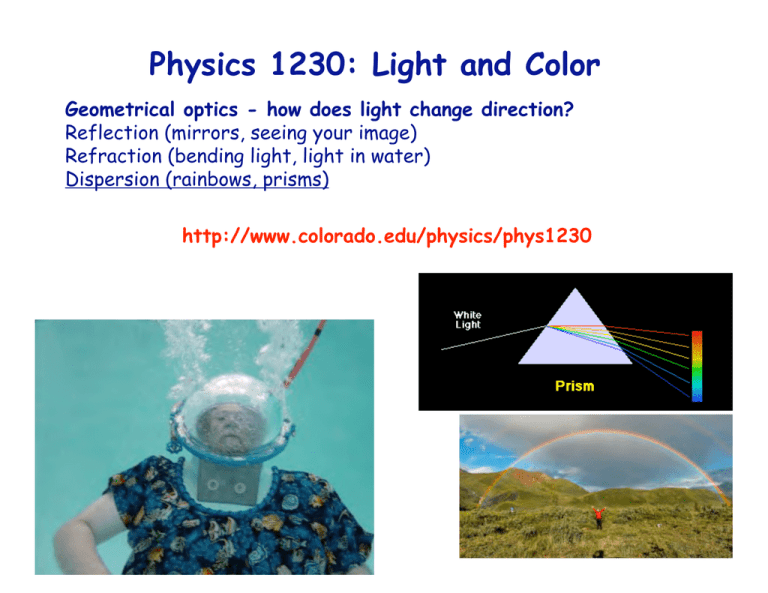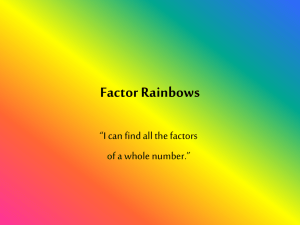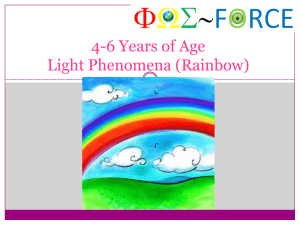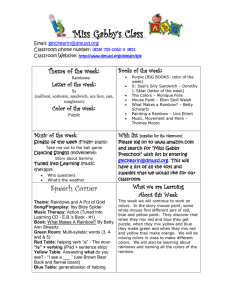Lecture 7 Dispersion
advertisement

Physics 1230: Light and Color Geometrical optics - how does light change direction? Reflection (mirrors, seeing your image) Refraction (bending light, light in water) Dispersion (rainbows, prisms) http://www.colorado.edu/physics/phys1230 Each color has a different wavelength and frequency, but the SAME SPEED in air http://science.hq.nasa.gov/kids/imagers/ems/index.html distance λ speed = c = = = λf time T Light slows down in materials compared with air • Speed in medium = speed in vacuum n • n = speed of light in vacuum speed of light in substance Concept Question • Speed in medium = speed in vacuum n • n = speed of light in vacuum speed of light in substance What is the refractive index of diamond? A. 1 B. 0 C. 1.5 D. 2.4 Concept Question Consider light propagating in glass where the index is n=1.5 What is the speed of light in glass? A) 3 x 108 m/sec B) 1.5 m/sec C) 2 x 108 m/sec Light slows down in denser materials this picture shows refraction without dispersion, as would occur with monochromatic light • Light waves incident on glass change direction and wavelength when transmitted into the glass because the part of the wave in the medium begins to slow down, causing the light beam to bend. • This is like when a marching band needs to make a turn http://acept.la.asu.edu/PiN/rdg/refraction/refraction.shtml Concept Question Which ray is drawn correctly? A, B or C? normal to surface incident ray A glass or water B C Concept Question Which ray is drawn correctly? A, B or C? A B refracted rays normal to surface reflected rays C glass or water incident ray Concept Question What is the angle of total internal reflection here? A) 41 degrees B) 90 degrees C) 49 degrees http://acept.la.asu.edu/PiN/rdg/refraction/refraction2.shtml Concept Question - Which Color bends more? If blue light travels slower than red light in glass and other materials, which color will bend more when it reaches an interface from air to glass? A. Red B. Blue C. Green Dispersion • Dispersion is a kind of refraction in which the amount of bending depends on the wavelength (i.e., the color) • This is because the speed of light in a medium depends on the color • In general for glass and similar materials, red light travels faster than blue light, but both slow down compared with the vacuum • Examples are the colors produced by prisms, diamonds and rainbows Dispersion by prisms • In a prism, the amount of bending depends on the wavelength or color because the speed of light depends on the color • In other words, the index of refraction depends on the color • Blue light has a higher index of refraction than red light, and thus is bent (refracted) more http://csep10.phys.utk.edu/astr162/lect/light/dispersion.html Dispersion by prisms • In a prism, the amount of bending depends on the wavelength or color because the speed of light depends on the color • In other words, the index of refraction depends on the color • Blue light has a higher index of refraction than red light, and thus is bent (refracted) more incoming light beam light made up of many colors Dispersion and Rainbows What is a rainbow? The traditional rainbow is sunlight spread out into its spectrum of colors and diverted to the eye of the observer by water droplets. The "bow" part of the word describes the fact that the rainbow is a group of nearly circular arcs of color all having a common center. Most people have never noticed that the sun is always behind you when you face a rainbow, and that the center of the circular arc of the rainbow is in the direction opposite to that of the sun. The rain, of course, is in the direction of the rainbow. How Rainbows Work Light is first refracted by the raindrops, then reflected once, and then refracted once again. Sunlight Dispersion causes the angle of refraction to be different for blue light than for red light. This is because the blue light travels more slowly in the raindrop than red light. What makes the colors in the rainbow? Rene Descartes and Willebrord Snell had determined how a ray of light is bent, or refracted, as it traverses regions of different densities, such as air and water. When the light paths through a raindrop are traced for red and blue light, one finds that the angle of deviation is different for the two colors because blue light is bent or refracted more than is the red light. This implies that when we see a rainbow and its band of colors we are looking at light refracted and reflected from different raindrops, some viewed at an angle of 42°; some, at an angle of 40°, and some in between. Why? This is illustrated in the figure. This rainbow of two colors would have a width of almost 2° (about four times larger than the angular size of the full moon). Note that even though blue light is refracted more than red light in a single drop, we see the blue light on the inner part of the arc because we are looking along a different line of sight that has a smaller angle (40°) for the blue. http://science.howstuffworks.com/rainbow2.htm http://astro.temple.edu/~dhill001/MCRain/MCRain.html Concept Question When is the sunlight separated into its component colors? A) When it first enters the raindrop B) When it reflects perfectly from the back of the drop C) When it exits the raindrop Concept Question Why don’t you see the blue at top and red at bottom of rainbow? How Rainbows Happen http://www.rebeccapaton.net/rainbows/index.htm A. I can explain this B. I don’t know Why are rainbows bowed? The rainbow ray for red light makes an angle of 42° between the direction of the incident sunlight and the line of sight. Therefore, as long as the raindrop is viewed along a line of sight that makes this angle with the direction of incident light, we will see a brightening. The rainbow is thus a circle of angular radius 42°, centered on the antisolar point. Why don't we see a full circle? A) Because the earth gets in the way B) Because there is no light to scatter C) This light becomes the second rainbow Why are rainbows bowed? The rainbow ray for red light makes an angle of 42° between the direction of the incident sunlight and the line of sight. Therefore, as long as the raindrop is viewed along a line of sight that makes this angle with the direction of incident light, we will see a brightening. The rainbow is thus a circle of angular radius 42°, centered on the antisolar point. We don't see a full circle because the earth gets in the way. The lower the sun is to the horizon, the more of the circle we see -right at sunset, we would see a full semicircle of the rainbow with the top of the arch 42°above the horizon. The higher the sun is in the sky, the smaller is the arch of the rainbow above the horizon. On an airplane, if you look into the clouds while the sun is behind you, you may be able to see a full 360° rainbow! What makes a Double Rainbow? Sometimes we see two rainbows at once. What causes this? We have followed the path of a ray of sunlight as it enters and is reflected inside the raindrop. But not all of the energy of the ray escapes the raindrop after it is reflected once. A part of the ray is reflected again and travels along inside the drop to emerge from the drop. The rainbow we normally see is called the primary rainbow and is produced by one internal reflection; the secondary rainbow arises from two internal reflections and the rays exit the drop at an angle of 50° rather than the 42°for the red primary bow. Blue light emerges at an even larger angle of 53°. This effect produces a secondary rainbow that appears higher in the sky and has its colors reversed compared to the primary. the secondary (upper) rainbow always appears fainter: why? What makes a Double Rainbow? Sometimes we see two rainbows at once. What causes this? We have followed the path of a ray of sunlight as it enters and is reflected inside the raindrop. But not all of the energy of the ray escapes the raindrop after it is reflected once. A part of the ray is reflected again and travels along inside the drop to emerge from the drop at a different angle. The rainbow we normally see is called the primary rainbow and is produced by one internal reflection; the secondary rainbow arises from two internal reflections and the rays exit the drop at an angle of 50° rather than the 42° for the red primary bow. Blue light emerges at an even larger angle of 53°. This effect produces a secondary rainbow that appears higher in the sky and has its colors reversed compared to the primary. the secondary (upper) rainbow always appears fainter: why? What makes a Double Rainbow? the secondary (upper) rainbow always appears fainter: why? http://mathdemos.gcsu.edu/mathdemos/MCRain/MCRain.html Making your own rainbows Get a fine misting sprinkler and set the water pressure high enough to get a large volume of water droplets in the air. * Where should you stand with respect to the water and the sun? * Find the shadow of yourself on the ground. Try to measure the angle from the shadow of your head to the rainbow arc. Use the "hand and fist" method to measure this angle: if you stretch out your arm and make a fist, the width of your fist is about ten degrees. Crazy Sprinkler Lady http://www.youtube.com/watch? v=ck7A9vufrX4&feature=related Concept Question Can the person see the rainbow? A. Yes B. No C. Maybe RAINBOW PUZZLER Rainbows are one of nature's awe inspiring sights. Artists have used them for inspiration without always understanding the physics behind a rainbow. The painting below, "Niagara", was painted by Henry Freeman in 1873. What is wrong with the rainbows in this picture? http://www.hands-on-optics.org/puzzler/ Galen Rowell: Potala Palace, Lhasa How did he achieve this composition? Rainbows in Art What’s wrong with this painting? Heroic Landscape, Joseph Anton Koch Moonbows: Lunar Rainbows time exposure taken at 8:30 pm, Victoria Falls, Zambia Rainbows in Mythology "There is a pot of gold at the end of every rainbow." What’s the problem with this proposition? Rainbows in Religion: Navajo Rainbow Guardian Isanakleshe (Changing Woman) and Natseelit (the Rainbow Goddess) and Sacred Corn © Sandra Stanton Navajo sand painting: Father Sky, Mother Earth enclosed on three sides by Rainbow Goddess http://www.jedisteve.com/navajo.html Rainbows and the Story of Noah Rainbows and the Story of Noah



